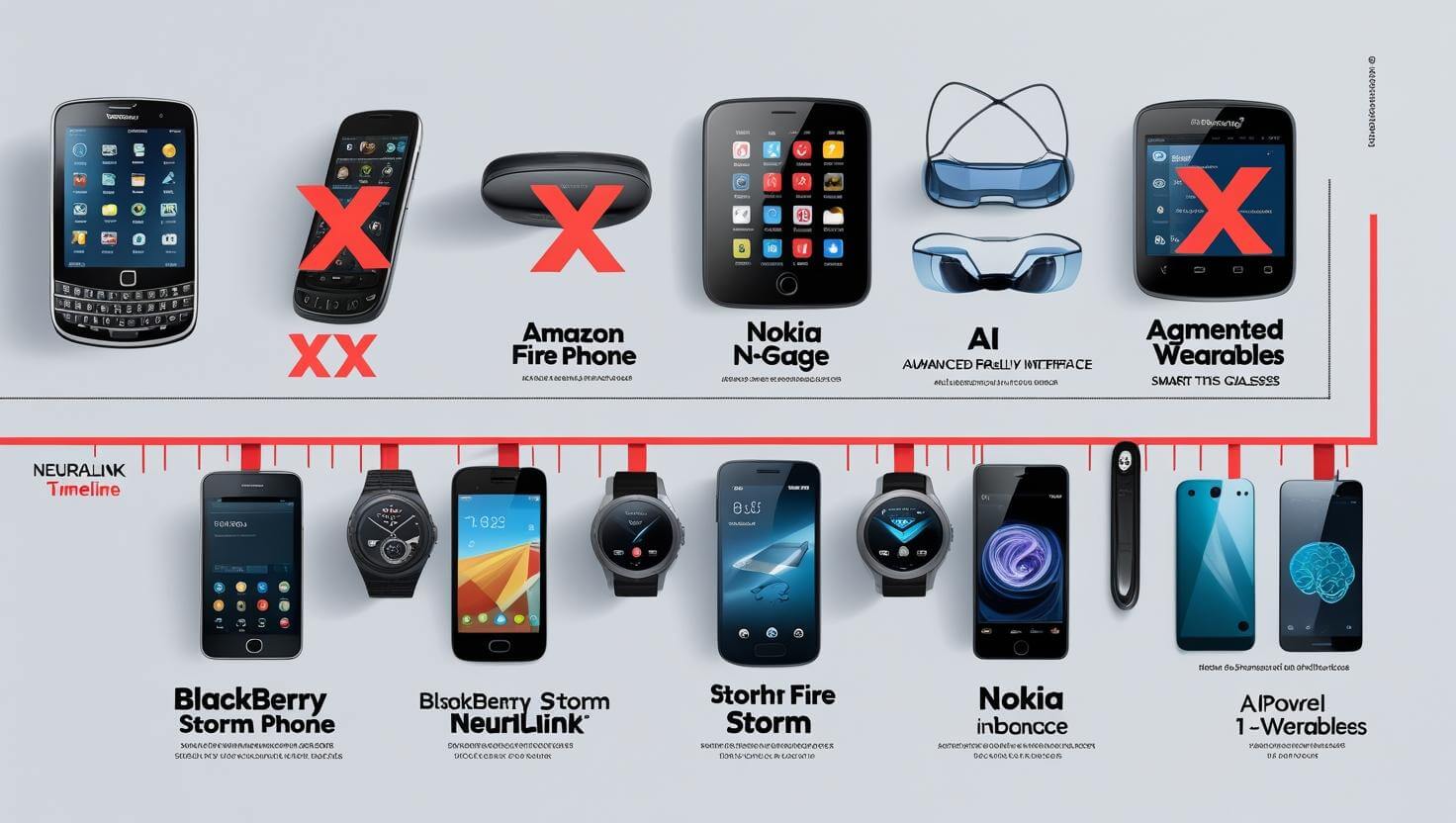What if the sleek smartphone innovation in your pocket is already a relic? Tech giants envision future beyond smartphones, and their visions aren’t just science fiction—they’re rolling out as we speak. From augmented reality glasses to AI-powered devices, the digital world is rapidly evolving, reshaping how we live, communicate, and connect. But not all bold ideas succeed. History is littered with flashy flops that tried to leap ahead—only to fall flat.
This article dives into 13 smartphone alternatives that crashed long before their time. These devices aimed to lead the mobile technology evolution but ended up as cautionary tales. Curious how they failed—and what they taught us? Let’s uncover the truth.
How Tech Giants Envision a Future Beyond Smartphones
The future of smartphones is currently being shaped by tech behemoths like Apple, OpenAI, and Meta. They envision human-computer integration, hands-free interaction, and smart glasses by 2030. Instead of touchscreens, they want users to interact with devices using their voice, eyes, or even thoughts.
Meta is building advanced AR headsets, Elon Musk is pushing Neuralink’s brain-computer interface, and Sam Altman recently teamed up with former Apple designer Jony Ive to develop a screenless future. These aren’t just cool gadgets—they could be the next phase of emerging tech interface.
What Went Wrong With Early Smartphone Innovations?
The road to today’s smart devices was bumpy. Some companies tried to innovate too fast. Others ignored technology adoption trends or failed to deliver real value to users. The digital user experience matters—and many early phones couldn’t provide it.
Some phones tried strange features that were hard to use. Others suffered from weak operating systems or lacked app support. Even bold projects like electronic tattoos and smart wearables from Chaotic Moon didn’t catch on. The lesson? Innovation needs timing, design, and practical use.
13. BlackBerry Storm – Touchscreen Misfire
One of BlackBerry’s earliest touchscreen phones was the BlackBerry Storm. It tried to copy the iPhone, but the touchscreen was hard to use. It didn’t feel natural. Users wanted smooth and easy swiping, not clunky clicks.
This failure was a reminder that copying without improving doesn’t work. It also showed how vital the digital user experience is in the mobile space.
12. Sony Ericsson Xperia PLAY – Gaming Phone Flop
Sony Ericsson Xperia PLAY mixed a phone and a gaming console. It had a slide-out controller that looked like a PlayStation. The idea was great, but it lacked games and power.
Gamers didn’t buy it, and phone users didn’t need it. It failed to meet the expectations of either group. The smartphone innovation here was exciting but not useful enough.
11. Amazon Fire Phone – Too Late to the Party
Strong Amazon services and cool 3D effects were built into the Amazon Fire Phone. But it came when smartphones were already advanced. It also lacked Google apps, which made it feel limited.
Amazon entered the game too late. They didn’t understand the need for open access and strong apps. Even powerful brands can’t win if they don’t fit the market.
10. Nokia N-Gage – Gaming Hybrid Gone Wrong
The Nokia N-Gage aimed to be both a gaming device and a phone. But it was hard to hold, and its buttons weren’t good for gaming. Even changing games required removing the battery.
Its poor design hurt its chances. It shows how good mobile technology evolution must focus on ease and comfort. Cool ideas need smart design.
9. Palm Pre – Ahead of Its Time, But Too Early
The Palm Pre had a beautiful new system called webOS. It supported multitasking and gestures, features that later phones copied. But it had poor marketing and weak hardware.
This phone shows that smartphone innovation can still fail if support and timing are wrong. Sometimes being first isn’t enough.
8. Nokia Lumia – Derailed by Windows OS
Nokia Lumia phones were well-built and had strong cameras. But they ran on Windows OS, which lacked the apps people wanted. It didn’t have Instagram or Snapchat when it launched.
The hardware was great. But the software ruined the experience. It reminds us that personalized tech must meet user needs.
The Nokia N-Gage aimed to be both a gaming device and a phone.
Project Ara, started by Google, aimed to create a phone you could build like LEGO. You could replace components like the battery or camera. But making it work smoothly was too hard.
It was a bold step into the next-gen communication devices world. But even tech giants can’t win with ideas that are too complex.
6. Microsoft Kin – The Social Media Phone Nobody Wanted
The Microsoft Kin focused on young people and social media. But it was expensive and lacked many normal phone features. It also didn’t have apps.
Teens didn’t buy it, and adults ignored it. It was a classic case of poor targeting in smartphone innovation.
5. LG Double Play—Two Screens, No Purpose
The LG Double Play had a second screen between its keyboard. The idea was multitasking. But the screen was tiny, and apps didn’t work well on it.
People didn’t need this second screen. It added confusion, not value. Tech disruption must make life easier—not harder.
4. HTC First – The Facebook Phone Fiasco
The HTC First came with Facebook Home, which took over your screen. It made Facebook the center of everything. But people didn’t like it. It felt too pushy.
This raised privacy concerns in tech. Users want control—not forced experiences. The failure showed why digital transformation must respect choice.
3. Asus PadFone – Tablet + Phone = Failure
The Asus PadFone was a phone that slid into a tablet shell. One device for both needs. But it was heavy, slow, and buggy.
The idea of smartphone alternatives was there. But the execution missed the mark. Even smart ideas need to work well.
2. Motorola Rokr – iTunes on a Dumbphone
The Motorola Rokr was made with Apple to play iTunes. But it was slow, had limited storage, and synced poorly. People didn’t like it.
Still, it helped Apple learn. Soon after came the Apple iPhone 16’s ancestor: the first iPhone. Even failures can light the way.
1. Samsung Galaxy Beam – Projector Power That Nobody Needed
The Samsung Galaxy Beam had a built-in projector. It could show videos on walls. But few people needed that, and it made the phone bulky.
In a world moving toward screenless interaction, this feature felt backward. A fun idea, but not practical for most users.

Conclusion: Why Even Bold Ideas Can Flop
These 13 phones show that being bold is not enough. Ideas must be useful, well-timed, and designed for real people. Many failed phones dreamed of a future like today’s—but couldn’t deliver.
Now, as tech giants envision future beyond smartphones, we’re watching real change. Wearable technology, artificial intelligence (AI), and smart glasses 2030 are not science fiction anymore. The Apple vs Meta innovation battle is heating up, and we may soon live in a screenless future.
Still, we must remember the past. Innovation must be smart, not just new. The future of smartphones depends on learning from these old mistakes and making better choices with AI-powered devices, biometric data collection, and better digital user experience.
FAQs:
- What device will replace the smartphone?
Likely candidates include AR glasses, neural interfaces, and AI-powered wearables offering hands-free, immersive experiences. - What will be the next big thing after smartphones?
Beyond smartphones, augmented reality (AR) and brain-computer interfaces are anticipated to drive the next technological revolution. - What will replace smartphones, according to Mark Zuckerberg?
Mark Zuckerberg believes AR glasses and the metaverse will eventually replace smartphones as our primary digital interface. - What is the future of the smartphone?
Smartphones will evolve with AI integration, foldable screens, and seamless AR/VR connectivity, but may become secondary to more immersive devices. - Which phone does Mark Zuckerberg use?
Mark Zuckerberg reportedly uses a Samsung Galaxy phone, often seen testing various Android devices for Meta compatibility.


